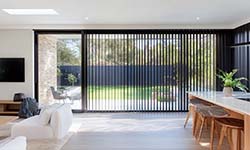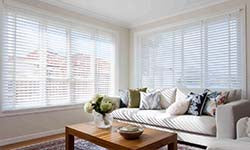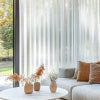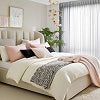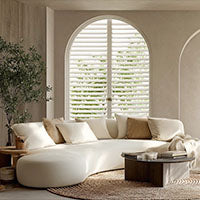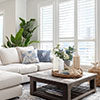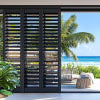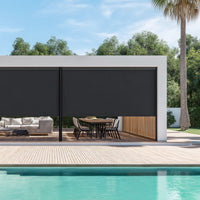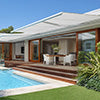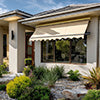What to consider when choosing new indoor blinds
With so many types of blinds to choose from, it’s hard to know where to start your search for your new window coverings. Here are a few things to think about to help narrow down your choices:
- How many blinds do you need to purchase for your home?
- What’s your budget for each blind?
- What kind of light control do you need? Do you need something to minimise incoming light, or to completely block it out at times?
- What style of blind do you like? Do you want horizontal or vertical slats, or would you prefer fabric blinds?
- Do you have a colour preference?
- Do you need blinds for wet areas? Think about choosing more durable materials options for these areas.
Types of indoor blinds
Choosing the right indoor blind for your home can make a massive difference in the overall function and styling of your room, and can ensure you get the best option within your budget.
Roller blinds
Roller blinds are a versatile window covering option for your home, which are easy to clean and maintain!
These blinds are made up of a single piece of fabric and are best suited to living areas and bedrooms. They also pair well with sheer curtains for that little bit more privacy and style!
There are two fabric options for roller blinds: blockout and sunscreen fabric.
Blockout fabric is the best option for rooms where you need total darkness at any time during the day or night, whereas sunscreen blinds are great for rooms exposed to direct sunlight.
Sunscreen fabric works by filtering incoming light and reducing the amount of UV coming into your room, which helps protect your skin, and furniture from fading.
To learn more about Roller blinds, visit our blog.


Lite roller blinds
Lite roller blinds provide a clean and modern look to any room, while also offering excellent light control and privacy.
Engineered with unique parts and a smaller tube, lite roller blinds offer exceptional performance and functionality for windows up to 1.8m wide.
Please be aware that lite roller blinds and standard roller blinds cannot be mixed or combined due to their distinct design and components.
Double roller blinds

For rooms where you want more light control and privacy, double roller blinds could be the right option for you.
Double roller blinds feature two rollers, each with a different fabric.
The main benefit of double rollers is that you can have one fabric rolled down while the other is rolled up. This means you’ll maintain plenty of privacy in your room, while still letting in some natural light.
Having both the two layers rolled down together also provides one of the best blockout blind options for your home.
The most common fabric combination for double roller blinds is blockout and sunscreen fabric as this gives you the most flexible light control and privacy options.
Vision blinds

Vision blinds are made up of horizontal slats with two layers of striped translucent and opaque fabric.
Also known as day and night blinds, these indoor blinds are a great option for 24/7 blockout functionality.
Roman blinds
Roman blinds consist of fabric panels, which can be raised or lowered to control incoming light.
These blinds are a great option if you’re wanting a more upmarket look and a blockout blind.
Learn more about Roman blinds in our blog.


Vertical blinds
Vertical blinds are a very popular blind option for new homes as they’re one of the most affordable yet very functional and high quality blinds.
These blinds are made up of a series of vertical-hanging slats of material that are attached to a track. You can rotate these slats to let in light or to create darkness, depending on your needs and the time of day.
There are two fabric options for vertical blinds: standard and blockout.
Learn more about vertical blinds in our blog.
Panel Glide blinds

Panel glide blinds are a type of vertical blind that’s made up of fabric panels, except these panels are much wider. These blinds are great for both windows and as room dividers to break up a larger space into smaller ones.
Find out more about panel blinds in our guide.
Vertisheer blinds

To achieve the look and feel of a sheer curtain, with the light control versatility of vertical blinds, try vertisheer blinds!
Best suited to living rooms and bedrooms, these blinds provide your space with an elegant finish.
Learn more about Vertisheer blinds in our blog.
Venetian blinds

Venetian blinds are made up of horizontal slats, which can be angled depending on where you want the direction of incoming light to go.
There are three types of materials to choose from:
Aluminium and Timber-look Venetians are the most versatile options, as they are suitable for any room in your home, including wet areas.
Timber Venetians are much more delicate and should only be used in bedrooms, living areas, or offices as exposure to water or moisture can cause them to warp and damage them.
Learn all about Venetians blinds in our complete guide.
Benefits of indoor blinds
Blinds are a great addition to your home, as they:
- Help regulate the temperature
- Enhance your décor
- Assist in managing the amount of incoming light
- Add privacy
- Protect your furniture from fading due to direct sunlight
- Make it easier to sleep at any time of the day or night
- Are an added security measure
- Can be motorised for added convenience
Are indoor blinds child-safe?
At Half Price Blinds, all of our blinds are child safe and meet International Standards.
Out of all our window coverings, the best option for children is our Eve MotionBlinds as they have no dangling cords.
There are other options if motorised blinds aren’t for you.
You could also consider a blind control option called the Securo wand. This is a cord that’s secured to the wall, meaning the cord isn’t hanging loosely for kids to play with.
For more information on choosing the best indoor blinds for your child’s room, head to our comprehensive guide!
Motorised indoor blinds
If you’re looking for a motorised blind option for your home, consider Eve MotionBlinds!
Eve MotionBlinds are a smart blind that’s compatible with Apple’s HomeKit.
The benefits of Eve MotionBlinds include:
- Easy charging using a standard USB-C cable (and only needs to be charged once or twice a year).
- Simple integration with your smart phone by scanning a QR code on the blinds. This QR code uploads all the data controls you need into your Apple HomeKit.
- An automation option to open and close, even when you’re not home.
Learn more about smart blinds in our blog.
Frequently asked questions about indoor blinds
Best type of blinds for bedrooms
The best blind for bedrooms depends on your taste and needs, but generally roller blinds, double roller blinds or Roman blinds are the best for these spaces.
All of these blinds have a blockout option, giving you plenty of darkness at any time of the day.
Blinds for wet areas
If you’re wanting to find indoor blinds for wet areas like your bathroom, kitchen or laundry, your best options are:
- Aluminium Venetians
- Timber-look Venetians
- Woodlux blinds
These blinds are made from more durable materials meaning they can withstand moisture and are likely to last longer.
To learn more about the best blinds for wet areas, head to our blog.
Indoor blinds for your living room
The living room is one of the hardest areas to choose blinds for as you need the flexibility to have complete blockout at times, while still having the option for plenty of light during the day.
To help you decide on what the right window coverings are, read our guide to living room blinds!
Blinds for your kitchen
Not sure what the right window coverings for your kitchen are? The best options are ones which are water resistant, easy to clean, and won’t get in the way.
Find out more about the best kitchen blinds in our blog.
Is it ok to have blinds without curtains?
Pairing blinds with curtains is an option you can consider, but if you don’t like curtains, or don’t have the budget for extra window coverings, indoor blinds will work well without them.
There are some cases where having a curtain and blind together is worth considering, particularly with Roman and roller blinds.
When these blinds are raised, there’s no privacy on your windows, so a sheer curtain is a great option to give your room privacy and natural light.
Blinds like Venetians and verticals have slats which can be opened enough to let plenty of light in, but still maintain some privacy and don’t benefit from curtains as much as other blinds.
Should you install blinds inside or outside the window recess?
Did you know there’s more than one way to install blinds?
You can choose between a recess fit or a face fit.
A recess fit is when the blind fits inside the window recess (the cut out in your wall) and it’s more of a snug fit. The benefit of a recess fit is that it helps to provide slightly more insulation as there’s less space for heat to transfer through.
A face fit is where the blind sits over the recess. Consider this option if you want to make your blinds more of a feature, or as a design choice to make your room feel larger!
Learn more about recess or face fit options in our blog.
Indoor blinds for sliding doors
Indoor blinds like verticals and panel glide blinds are two of the best choices for sliding doors!
Both of these blinds are designed with vertical slats hanging from the track and can easily be moved to the side to give you unrestricted access to your door.
Blinds with horizontal slats will block the top of the door frame and could get damaged as they aren’t completely out of the way.
Find out more about the best sliding door blinds in our blog.
Best indoor blinds on a budget
The top three best blinds on a budget are roller blinds, Venetian blinds, and vertical blinds.
These affordable blind options are more basic than other styles of blinds, but still provide great light control, colour choices and versatility.
To get more of an idea of the types of blind options for your budget, read our detailed guide!
How to clean blinds
Keeping your window coverings clean is a simple process when it’s maintained regularly.
The easiest cleaning hack is dusting your blinds every so often. Dust tends to stick to the fabric and not only makes your blinds look dirty, but it also makes it difficult for allergy sufferers!
For fabric blinds, dusting can be done using a feather duster or the end of your vacuum cleaner. For slatted blinds like Venetian blinds, our favourite way to remove dust involves putting a clean sock on your hand, and then running it over the slats.
For more information about cleaning your blinds, visit our website.
Buying DIY indoor blinds online
Buying blinds online is very simple when you follow these steps:
- Do your research into what kind of blinds you might like, and the benefits of that blind.
- Order your free fabric samples to help you decide on the right colour and fabric for your home. Seeing it online and in person is very different, which is why samples are so helpful!
- Measure your windows! If you’re not sure where on your windows you need to measure for different indoor blind styles, find everything you need to know in our handy indoor blind measuring guide.
- Find the best price for the blinds you want. At Half Price Blinds, our team will price beat competing quotes by 10%*! Learn more about our price beat guarantee on our website. *T&Cs apply.
- Patiently wait for your delivery so you can get out your tool kit and start installing your blinds.
Installing DIY blinds
Installing DIY blinds is something you can do easily by following our helpful guides for different types of indoor window coverings.
Find out how to install your new blinds on our website.
Interested in indoor blinds for your home? Why not get in touch! You can reach us via Facebook or by calling my Australian customer support team on 1300 699 041. They'll beat any competing in-store or online blind quote you may have by a huge 10 percent!
You can find all of our shutters, awnings, curtains and blinds online for the lowest prices, guaranteed. Plus, we deliver Australia-wide from Perth to the east coast and offer free shipping on metro orders over $449. For all other orders, shipping is $27.

